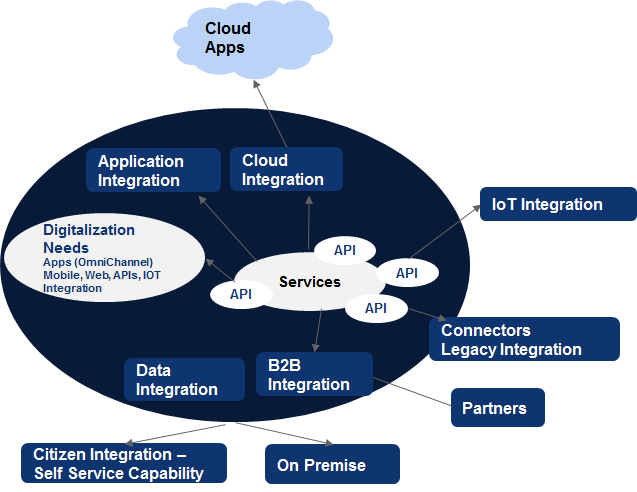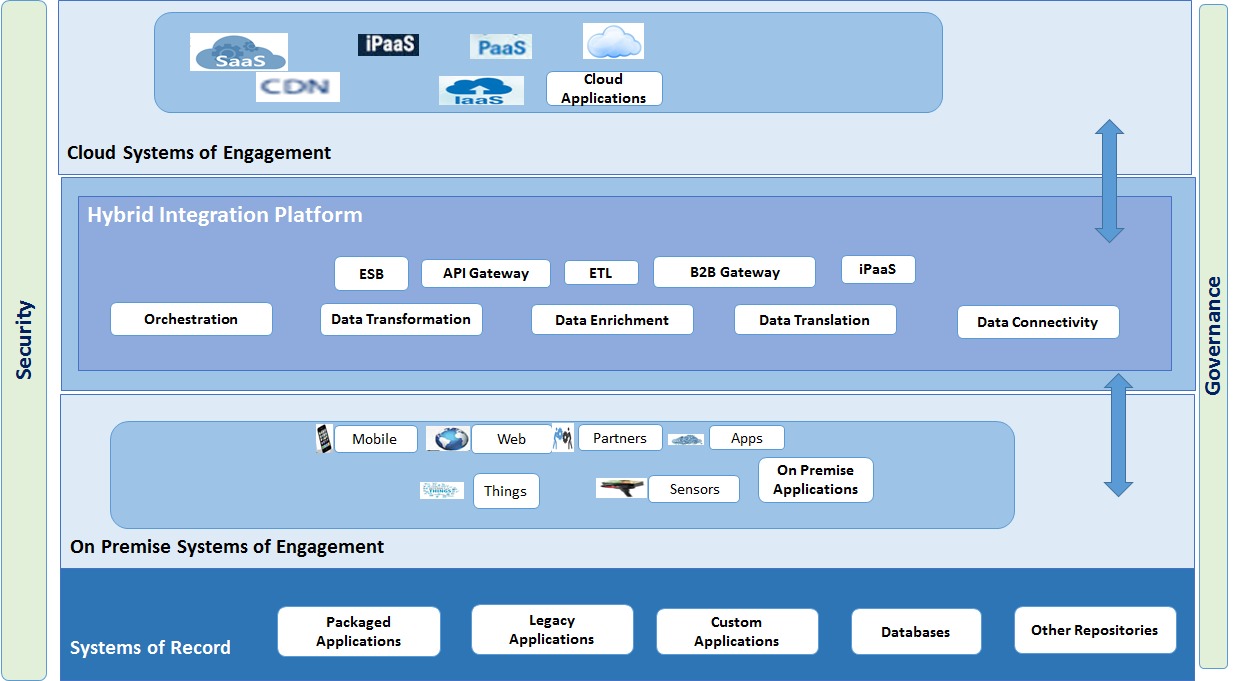Hybrid Integration in the Cloud
As more and more businesses move their data to the cloud, a hybrid integration architecture will begin to take hold. Read on to see what this could look like.
Join the DZone community and get the full member experience.
Join For FreeKey Takeaways:
- Hybrid Integration
- Factors influencing New Age integration Needs across industries
- Why hybrid integration is the answer to integration challenges in a cloud-first world
- Key aspects of a Future Integration Strategy
Why Hybrid Integration Is the Answer to Integration Challenges in a Cloud-First World
New business initiatives are compelling organizations to adopt modern architectures which are based on non-monolithic architectures, owing to the large-scale adoption of cloud, dynamic integration needs of systems of engagement, digitization, and IoT. Organizations who opted for SOA and ESB technologies as their strategy for handling integration are now realizing that they do not comprehensively address the new complex and emerging integration scenarios.
There is a need for defining a new age integration strategy and architecture, to address the need to integrate anything and anywhere. In order to achieve that, organizations should build an effective hybrid cloud integration platform to enable seamless connectivity between the systems and services across the enterprise, and also reap the benefits of cloud computing while taking into account security, flexibility, scalability, and manageability.
Factors Influencing New Age Integration Needs Across Industries
The move towards Hybrid Cloud: Organizations are trying to leverage the cloud for operational innovation, revenue model innovation and business model innovation, application modernization, cost-effectiveness, agility, availability, efficiency, rapid scalability and the ability to respond faster. A major portion of processing, systems of engagement, and systems of insight are moving to the cloud. As a result, applications, data, and process integrations should be able to support both cloud-based applications and on-premise systems.
A Cloud-enabled ecosystem and business model not only enables the IT staff but also the LoBs to respond to real business opportunities by forging closer ties with customers and creating innovative customer touch points.
Disconnected Silos of Data: Fragmentation of processes and data is caused by the increasing adoption of cloud especially SaaS. Data is scattered across on-premise and cloud. For example, Lines of Business (LOBs), such as marketing, sales, customer support, etc. can consume data from multiple and disparate SaaS applications.
The move towards IoT: Organizations are focused on leveraging IoT as a driver of incremental revenue streams based on new products and services and to improve productivity and save costs, reduce operational overhead, and optimize operational efficiencies. Enormous data that gets generated needs to be integrated and processed to derive appropriate insights to make real-time decisions.
For example, the deployment of IoT-based smart energy solutions results in better field communication, reduced cost of maintenance, real-time monitoring, digital oil field infrastructure, reduced power consumption, mining automation, greater safety and security of assets, and thus higher productivity.
The move towards APIs and Digitalization: Organizations are crossing over traditional boundaries into new markets and new industries—driving new levels of growth and profitability. As organizations build or partner in industry platforms, new digital ecosystems are growing around them which will become the foundation for the next major stage of technology and economic disruption.
To promote their business in a more innovative way, organizations are focusing on innovative digital abilities, such as mobile enablement for employees, location navigation, leveraging new digital channels (omnichannel experience), enhanced customer experience, expansion in online marketing efforts, digital field operations, exposing data as a service, energy consumerization, etc. This has also led data such as sales data and logistics data to be exposed across multiple devices accessible from anywhere.
Enterprises need to integrate with third parties, including partners and suppliers, subscribe to data feeds for real-time intelligence, and the products they build should integrate with other organizations.
As the adoption of cloud increases, data that exists outside the organization's firewall needs to be managed and controlled while managing BYOD (Bring Your Own Device) policies, wherein employees want to access the data using any device from anywhere.
This has resulted in the need to adopt microservices and API management, which help in providing the required agility and scalability.
Integration is the main foundation for enabling organizations to adopt digitalization.
Ability to Support Citizen Integrator Capabilities:
As organizations embrace digitalization, there is a need for agility, dynamic integration, user interface and customer experience capabilities, and velocity. Old integration methodologies will not suffice to meet the scale of connectivity required to support digital business. The result is to enable business users to perform self-service tasks to integrate data and applications with integration tools which provide citizen integrator tools that combine data and application integration that support HIP capabilities.
Future Integration Strategy
Over time, organizations will have created a scattered landscape with disparate disjointed solutions to cater to the integrating needs like point-to-point connectivity to a SaaS provider, etc.
We believe that the majority of large enterprises will continue to use on-premise systems for systems of records but will turn to hybrid integration models that combine on-premise and cloud-hosted systems to handle new integration scenarios.
Enterprises should consider hybrid integration for connecting a system of engagements to a system of records, a system of insights, a system of automation and a system of design, which are spread across on-premise and cloud.
Hybrid cloud integration defines a holistic integration approach, which utilizes both the traditional investments in the on-premise applications, along with the new and innovative cloud technologies, so the organization can take full advantage of the new and changing enterprise landscape.
The key characteristics of the Hybrid Cloud Integration platform include:
- Integrate heterogonous applications and systems to communicate effectively.
- Provide a comprehensive approach to integrate on-premise and cloud applications.
- Expose APIs, manage APIs, manage and expose data securely via APIs.
- Provide velocity to develop and deploy next-gen applications on-premise or to the public cloud.
To address the new integration scenarios and patterns, an integration strategy in line with the digital era requirements for agility and adaptability needs to be formulated and renovate the integration platform strategy. Organizations should implement a hybrid integration platform by selecting and aggregating the combination of cloud-native and on-premise integration platforms that best support an organization’s requirements. Enterprises should move towards a new integration strategy which will have consolidated application and data integration capabilities with more hybrid integration capabilities than on-premise or cloud.
Key components of integration that should be taken into account include Application Integration, Data Integration, Process Integration, Cloud Integration, and Infrastructure and Security.
The application, data, and process integration strategies complement and enable each other to create a coherent and complete framework, supported by the on-premise and cloud infrastructures, with adequate security considerations.
The integration strategy should include reshaping the organizational model by repositioning the traditional, centralized integration teams from a "software factory" model toward the role of facilitator for HIP-enabled, do-it-yourself integration that is carried out by lines of business (LoBs), subsidiaries, departments, application development (AD) teams, and even business users.
A sound HIP strategy must start with an analysis of:
The integration capabilities already in place in the organization provided by the existing integration platforms.
The anticipated short-term, medium-term, and long-term integration needs based on the organization's needs.
The Wide Range of Integration Choices
Integration choices |
Description |
Use Cases |
iPaaS |
Dynamic integration solutions that operate exclusively in the cloud. |
Develop integration solutions in a dynamic environment to support systems of engagement and systems of record. |
aPaaS |
APIs and real-time integration which covers real-time use cases. |
Build new application solutions, including interfaces for other applications. |
Mediated APIs |
The mediated APIs architectural model is a solution for enriching and protecting interactions between distributed components, to help service-enabled legacy and packaged applications, and bridge the differences between legacy applications and more modern systems. |
The model inserts a mediation layer between API consumers and API providers which monitors and manages the interaction, reconciles technical and semantic differences, and encapsulates and abstracts the applications behind the API so that they can change and scale without affecting the API consumers. |
Integration SaaS (iSaaS) |
Cloud-based, self-service integration platforms, primarily targeting "citizen integrators." iSaaS offerings focus on enabling fast, "no-developer-required," mainly cloud-to-cloud or mobile-to-cloud integration. |
Leveraged by business users or line of business (LoB) leaders, not application leaders. |
Rekha Kodali is an Enterprise Architect with more than 20 years of experience in Microsoft Technologies. Her focus areas include .Net, ASP.NET, Azure, Micro services, API Management, IOT, BizTalk Server, Web Services, SharePoint, Office 365, SQL Server, ESB and SOA.
Stephen David has over 19 years of experience in the area of consulting, architecture, implementation and development. His core expertise is on Enterprise Integration covering various middleware integration platforms including open source, API Management and SOA.
Opinions expressed by DZone contributors are their own.

Comments